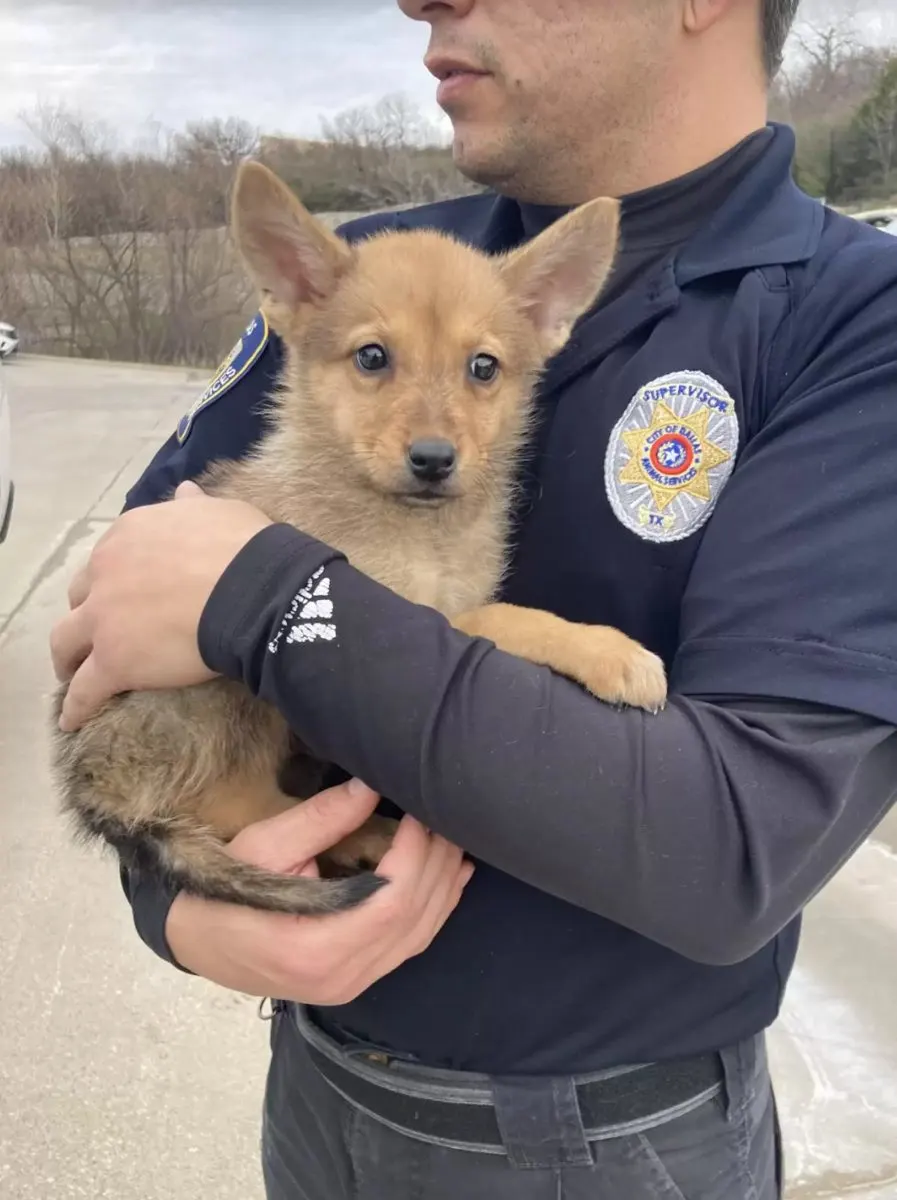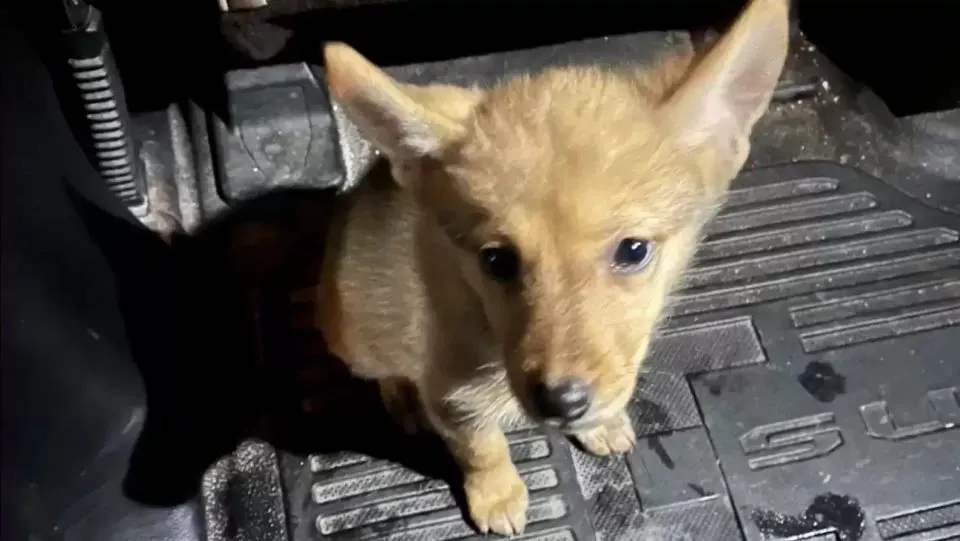Earlier this year, officers from the Dallas Police Department found a very young animal huddled next to a dumpster on their regular patrol duty in southern Dallas, Texas.
The animal was a caramel-coloured puppy-lookalike, undoubtedly very cute, but the officers weren’t exactly sure what it was.
This little baby looked an awful lot like a baby fox or even a coyote, but the officers simply couldn’t figure out its true identity.
No matter what, the little baby desperately needed to be rescued, so the police officers kept it safe and warm until Dallas Animal Services came to pick it up.
Puppy Or Coyote?

The discovery of this “mystery animal” caused quite a stir in the media all over the country. Was it a puppy mutt or a coyote? And, what would happen to it?
Although officials with Dallas Animal Services didn’t think the animal was a coyote, they couldn’t say for sure.
The animal did indeed look similar to a coyote pup after all.
Dallas Animal Services officer Jacqui Sutherland, its temporary foster parent, had her own suspicion. She told WFAA, “My money is on domestic. If I had money, it would be on domestic.”
With its tan coat and big ears, the possibility of being either of both species was very high, though.

So, they decided that the only reasonable thing was to do a DNA test and find the truth once and for all.
While they awaited the test results, they decided to give a name to this “mystery animal” that attracted a lot of attention.
So, meet Toast – the cutest mystery in Texas.
Drum Roll, Please

Finally, after almost two weeks of waiting, Embark Vet came out with the big reveal.
“Toast is a DOG! 🐶 As we suspected, she turned out to be a beautiful little mutt,” Dallas Animal Services announced in their Facebook post.
Her DNA results showed she is:
42% German Shepherd
38% Siberian Husky
20% Australian Cattle Dog

Toast had the Internet stumped for weeks, debating whether she was a puppy or a coyote, and now the truth is finally revealed.
She is a beautiful little puppy, saved from a life which consisted of eating out of a dumpster.
With Toast’s breed reveal finalized, the only thing left to do was find her a furever home. It took only five minutes for her to receive the maximum amount of applications, so she was quickly adopted.
“Toast has found a home, but the Dallas area is overwhelmed with dogs and many large-breed dogs and moms with pups are looking for fosters and forever homes,” Embark Vet wrote in their Facebook post.

We couldn’t be happier that Toast’s journey ended happily ever after, but our wish for other abandoned dogs and strays to find their happily ever after still remains.
Visit here to find other adoptable pets waiting for their family.
If you’ve ever had the pleasure of petting a dog, you’ve probably noticed how they absolutely adore belly rubs. It’s like hitting the jackpot of canine happiness! As a seasoned dog trainer, one thing’s for sure – there’s something truly special about the way dogs react when their bellies are gently rubbed. Picture this: a wagging tail, a contented sigh, and those soulful eyes looking up at you with pure joy. It’s a heartwarming moment that never fails to bring a smile to your face.
Understanding Canine Behavior
The Pack Mentality and Affection
Dogs are pack animals at heart. In a pack, they show their affection through physical touch. When you rub their belly, they feel a sense of security and belonging, just like they would in a pack setting. Belly rubs mimic the social grooming behavior that dogs share within their packs, reinforcing their bond with you.
Dogs and Physical Contact
Physical contact is vital for dogs. By giving them belly rubs, you’re communicating in their language of touch. This physical interaction releases endorphins that help them feel relaxed and happy. It’s a way for them to connect with you on a deeper level, strengthening the emotional bond between you and your furry friend.
The Science Behind Belly Rubs
Belly Rubs and Pleasure Hormones
When you give your furry friend a belly rub, it triggers the release of oxytocin and serotonin in both you and your dog. These hormones are responsible for feelings of love and pleasure, creating a positive experience for both of you. The physical interaction during belly rubs fosters a sense of connection and happiness, reinforcing the bond between you and your canine companion.
The Trust Factor in Exposing the Belly
For dogs, showing their belly is a vulnerable position that demonstrates trust and a feeling of safety. When your dog exposes their belly for a rub, it signifies a deep level of comfort and security in your presence. By reciprocating this gesture with gentle belly rubs, you strengthen the trust between you and your dog, enhancing your relationship and creating a safe space for them to feel loved and cherished.
The Benefits of Belly Rubs for Dogs
Strengthening the Human-Dog Bond
Belly rubs aren’t just enjoyable for your furry friend; they also play a crucial role in strengthening the bond between you and your dog. When you pet your dog’s belly, it’s a moment of shared happiness and trust. Your dog feels safe and loved when offering their vulnerable belly for a rub, showing a deep level of trust in you. By reciprocating with gentle belly rubs, you reinforce this bond and create a stronger connection, enhancing the relationship between you and your dog.
Health Benefits for Dogs
Apart from the emotional benefits, belly rubs can also have positive effects on your dog’s health. The physical touch involved in belly rubs can help reduce stress and anxiety in dogs. This simple gesture releases feel-good hormones like oxytocin and serotonin, promoting relaxation and well-being. Moreover, regular belly rubs can be beneficial for your dog’s circulation and digestion, contributing to their overall health and happiness. So, the next time your dog rolls over for a belly rub, it’s not just about fun; it’s also a way to keep them healthy and happy.
Recognizing the Signs Your Dog Wants a Belly Rub
Body Language Cues
When your dog wants a belly rub, pay attention to its body language. Typically, dogs that seek belly rubs will display signs of joy and trust. They may roll onto their back, exposing their belly as a gesture of vulnerability and comfort. Look for relaxed body posture, wagging tails, and possibly even pawing playfully at you.
Vocalizations and Movements
In addition to body language, vocalizations and movements can also indicate your dog’s desire for a belly rub. Listen for happy barks, whines, or even soft growls that suggest excitement and anticipation. Watch for gentle nudges or leaning against you, signaling a request for affection and attention. These cues often convey a sense of closeness and bonding between you and your furry companion.
When Not to Give a Dog a Belly Rub
Recognizing Signs of Discomfort
If your dog pulls away, flinches, tenses up, or shows other signs of unease when you try to give them a belly rub, it’s essential to recognize these signals. Dogs, like humans, have preferences, and not all of them enjoy belly rubs. Remember, just because a dog is friendly doesn’t mean they want their belly rubbed.
Respecting Your Dog’s Boundaries
Respecting your dog’s boundaries is crucial. If your dog doesn’t seem interested in a belly rub, it’s best to refrain from insisting. Pushing your dog beyond their comfort zone can create stress or distrust, impacting your bond. Pay attention to your furry friend’s cues and always respect their personal space and choices.
Conclusion
You’ve learned that dogs adore belly rubs not just for the physical pleasure but for the emotional connection they bring. Understanding your furry friend’s cues and body language is key to knowing when they crave that belly rub bliss. Offering belly rubs isn’t just about the feel-good moment; it’s a way to strengthen the bond and trust between you and your pup. Remember, it’s essential to respect your dog’s boundaries and signs of discomfort to maintain a happy and trusting relationship. So, next time your dog rolls over, ready for a belly rub, embrace the opportunity to deepen your connection and share a joyful moment together.
Frequently Asked Questions
Can belly rubs benefit dogs emotionally?
Yes, belly rubs can benefit dogs emotionally by triggering the release of oxytocin and serotonin, promoting feelings of happiness and bonding between the dog and its owner.
How can I tell if my dog wants a belly rub?
Signs that indicate a dog wants a belly rub include rolling onto their back, displaying joy and trust through body language cues, happy vocalizations, and gentle nudges to encourage physical closeness.
Are there health benefits to giving dogs belly rubs?
Yes, giving dogs belly rubs can reduce stress levels, improve overall health and happiness, and strengthen the bond between the dog and its owner through positive physical touch interactions.
[no_toc]

Hey there, I’m Janet Brooks, a dog-loving student from California. I’m all about helping pups in need, especially those without homes. Me and my awesome friends work together to give shelter and love to stray dogs. Oh, and I also write blogs about dogs to share helpful info.